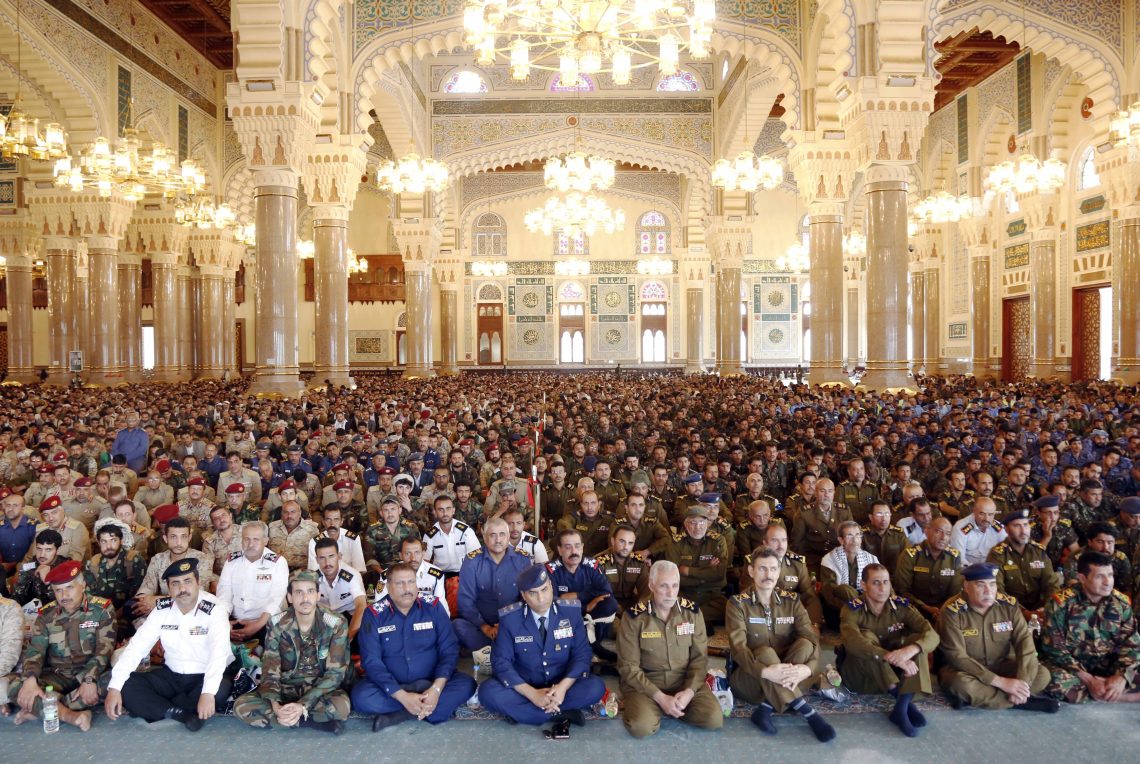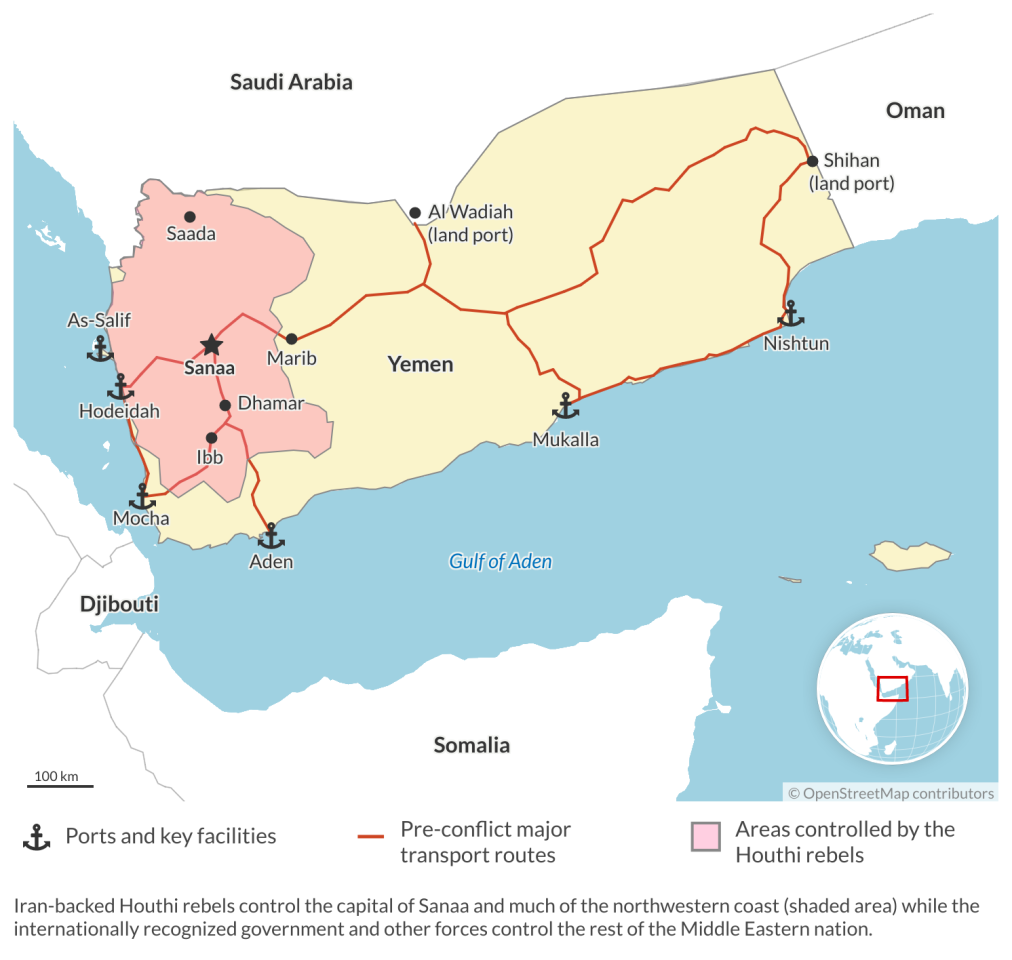New hope for an end to Yemen’s civil war?
While fighting goes on between the Yemeni government and Houthi rebels, renewed diplomatic relations between Iran and Saudi Arabia may invigorate peace talks.

In a nutshell
- Houthis seeking a new government and more oil revenue started the war in 2014
- Saudi Arabia backs the Yemeni government, while Iran supports the Houthi rebels
- The fighting has created a humanitarian disaster, but donations are falling short
The civil war in Yemen, now in its ninth year, has ravaged the Middle Eastern nation of 33 million people and remains fueled by control over the oil industry.
The restoration of diplomatic relations between Iran and Saudi Arabia, two nations supporting opposite sides in the conflict, has given renewed hope for ending the fighting that has taken at least 150,000 lives since 2014. In one of the world’s worst humanitarian disasters, half the population needs financial and food assistance.
Yet the fighting goes on, driven by a familiar prize: oil.
Block 18 is one of the country’s most productive oil fields, ideally situated on the shores of the Red Sea, a region whose gross domestic product (GDP) is expected to triple from $1.8 trillion to $6.1 trillion by 2050.
The field is barely functioning, and security conditions are precarious. Oil is the major source of revenue for the Yemeni government, backed by Saudi Arabia, to support its war effort against the Houthi rebels, whom Iran supports. Yemen ranks only 53 among nations in oil production, at roughly 70,000 barrels per day.
Other parts of the economy are in dire shape. Yemen imports nearly 90 percent of its wheat and all its rice. Financial loans – including $300 million from the International Monetary Fund (IMF) and $1 billion from the Arab Monetary Fund (AMF) – have been secured. However, most of it goes to pay civil servants and the army.
The Houthi rebels fighting the government also want to benefit from oil revenue, including paying salaries of civil servants in the regions they control. Without revenue sharing, they threaten to continue harassing supertankers approaching the Yemeni coast. The ultimate risk is that the Houthis will cut off the international shipping route through the Red Sea.
Parallel marketplace
Despite its modest production, the Yemeni equation affects the world hydrocarbon market, given the involvement of Saudi Arabia, the world’s second-largest oil producer, and gas-rich Iran.
Riyadh has led a military coalition in support of the officially recognized government for eight years. The fierce fighting and pacification of rebel areas have caused considerable damage in terms of people killed, displaced or impoverished and the destruction of infrastructure. While Saudi bases (Morra, Al-Anad) protect production sites, its naval forces monitor approaches to the port of Hodeidah to cut off rebel supplies and curb arms smuggling from Iran. The latest six-month cease-fire stipulated that international tankers could dock at the port of Hodeidah to deliver fuel to the rebels.
Because of the strategic importance of the Hodeidah port area, the Yemeni government has tried to enforce Decree No. 49, which requires customs duties to be paid at sea before ships dock. Application of the decree has failed. Not only has economic activity been transferred to other ports, but the Houthis have consolidated their model of governance, which is a cocktail of dirigisme and business. Most of their income comes from selling imported fuel, which they distribute on a parallel market. According to local estimates, the port of Hodeidah earns between $30 million and $40 million a month.
Threats and overbidding
Although the Houthis control the capital, Sanaa, and its institutions, as well as a good share of the northwest, access to fossil fuels remains a challenge. Despite the failure of their latest offensive to control the oil sites in Marib, they are not giving up, convinced that this is the right strategy.
Threatening oil infrastructure is a way of grabbing the international community’s attention, which is tired of this endless conflict. It is also a powerful message from Iranian leaders, the Houthis’ main ally, to remind the international community that they can influence the global hydrocarbon market.
When Houthi drones hit Saudi Aramco’s Abqaiq plant in 2019, global supply fell by 5 percent and the price per barrel briefly rose by about $2. Rebel attacks target Rudum, Qena (Shabwa) and Al-Shihr (Hadramaut) port facilities. Abu Dhabi National Oil Co. storage tanks are also targeted. Samad- and Qasef-class loitering munition ldrones target supertankers approaching the Yemeni coast held by government forces.
According to security sources, the Houthis have dug two small channels to hide speedboats that could appear in the open sea and launch lightning attacks on maritime traffic. Since the cease-fire ended on October 22, the Houthis have launched two drone attacks on oil terminals in Hadramout and Shabwa.
The United States, the Arab League and the European Union have repeatedly condemned this “unacceptable threat to international maritime trade and freedom of navigation.” International companies, used to deteriorating security environments, are throwing in the towel. The Canadian company Calvalley Petroleum has suspended its activities in Hadramout. The French company TotalEnergies wants to leave Yemen Liquified Natural Gas, trying to minimize its losses.
Facts & figures
Since the end of the cease-fire
The United Nations’ special envoy to Yemen, Hans Grundberg, is working on a political solution. The envoy’s regional tours regularly pass through the Sultanate of Oman, which is in contact with all the warring parties.
Saudi Arabia participates in the UN process but remains convinced that only direct talks with Houthi leader Mahdi al-Mashat would be effective. Mr. Mashat has agreed to bilateral meetings but insists that any future peace agreement must exclude the current government, and Riyadh cannot accept such a request, at least officially.
As fighting continues around Taiz, rumors of a quiet resumption of talks are circulating in the Arab press. Houthi spokesman Mohammed Abdel Salam confirmed the existence of “talks back and forth with other parties” without giving further details. The Saudis have shown signs of goodwill, especially on the humanitarian issue, which is catastrophic; two-thirds of the population needs aid and protection. Mine-clearing operations in the countryside are underway to destroy antipersonnel mines and unexploded ordnance that constantly threaten civilians.
Riyadh’s desire to resolve the conflict seems sincere. The Saudi foreign minister says he believes in the possibility of a negotiated solution, the first step of which could be the signing of a new cease-fire. However, this desire to end the conflict quickly has led the Houthi rebels to push harder. Iran’s role in this process is unclear. There is no indication that its Chinese ally would welcome Tehran moving the Houthis to block the Strait of Hormuz or exacerbate insecurity in the Red Sea.
The rebels are demanding back pay for civil servants working in areas under their control, mainly in the capital Sanaa. They want an entirely restructured government to take power in Yemen in which they will dominate the political scene. They also demand the complete withdrawal of foreign forces (the Arab Coalition) and a fair distribution of the benefits of oil activities to the entire Yemeni population. If they do not get their way, the spokesman for the Houthi military wing, Yahya Saree, threatened: “Our forces are capable, with God’s help, of depriving the Saudis and Emiratis of their resources if they insist on depriving our Yemeni people of their resources.”
The unknown remains the resilience of the warring parties and their respective allies. Before 2014, Yemen was a poor country and today it is anemic, crushed by a fratricidal conflict that has spared no one and threatens to destroy the state. In February 2023, the UN held an international donor conference to support a $4 billion humanitarian aid plan for Yemen, but pledges came up far short – only about $1.2 billion in commitments. The country has joined the unenviable group of forgotten conflicts.
Scenarios
In the first scenario, the war stalls as Saudi Arabia and Iran press for an end. Having failed to take control of the oil fields, the Houthi rebels could seek to increase their political autonomy. The country is effectively divided. The decision by the Southern Transitional Council (STC) to declare itself autonomous in 2020 may be irreversible. Two economic zones coexist. The Houthis use the old riyal in their areas. The Yemeni government has new banknotes printed by the Central Bank of Aden. Yemen’s warring brothers could agree to a cease-fire that returns the country to its 1967 division when South Yemen became independent.
In the second, more likely scenario, the exhausted warring parties reach an agreement on the distribution of oil revenues. The Houthis and their Iranian ally can present this scenario as a victory. Tehran would hope that such an agreement will strengthen its presence in the Gulf of Aden, through which 10 percent of the world’s maritime traffic passes. But Iran could become quickly disillusioned. The Houthis are transactional allies, and they remain essentially autonomous. Like the Afghans, they are valley people for whom every village, every hamlet and every house is “holy ground” (hijra). The tactical differences between the Houthis and the Iranians are real. Only the immediate interests of the Houthis are convincing them to remain in the Axis of Resistance promoted by the Islamic Republic of Iran.










